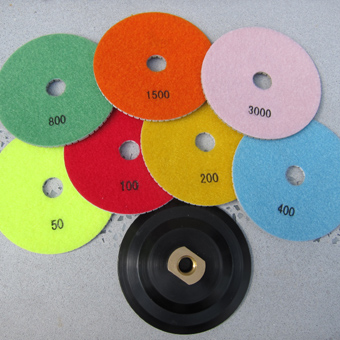Grinders use diamond discs or pads to grind and hone the concrete. There are multiple types of diamond discs that are used in progression to shape and smooth the concrete.
Turbo-Cups
For coarse grinding where large amounts of material must be removed quickly (such as when glass, stone or other embedments must be exposed), a coarse turbo-cup wheel is used. Turbo-cups are rigid, all metal discs that have thick, diamond impregnated metal segments mounted along the outer edge of the disc’s face.
Turbo-cups come in a variety of styles and sizes. The most useful are coarse discs that are 5” or 6” in diameter. Larger diameters spin faster (and therefore cut faster) and are more stable and less likely to dig into the concrete. Smaller diameter turbo-cups are useful for smaller sections of concrete and for edges. A special edge wheel is available that has a smoother face and wider diamond segments. Some turbo-cups are designed to be run dry or wet; it depends on the style and manufacturer.

Diamond Pads
To smooth the concrete after grinding with a turbo-cup wheel, or to perform light grinding on concrete that does not have embedments in it, coarse resin diamond pads are used. Diamond pads are thin, flexible, Velcro-backed, diamond-impregnated plastic discs that stick to a Velcro faced backer pad. Some are designed for wet grinding, and others are designed for dry grinding. The backer pad can be flexible or rigid, and can be either plastic or metal.
Diamond pads come in a variety of grits, from 50 (coarse) to over 3000 (ultra fine). Generally diamond pads at the coarser range (50 grit to 200 grit) are used for honing, while finer grits (400 to 3000 grit) are used for polishing.
It is important not to skip grits. Each diamond pad (e.g. 200 grit) removes the scratches left by the previous diamond pad (e.g. 100 grit), but a 200 grit diamond pad is not able to remove scratches left by a 50 diamond pad, for example.
Which diamond pad grits do I need to use?
It’s unnecessary to use a grit finer than 200 (or so), unless a polished, bare concrete finish is desired. Usually only the 50 to 200 grits are used. A 200 grit disc produces a very smooth but matte surface. Most topical sealers will not stick to a surface honed finer than 200 grit.
Even if a sealer will stick to a polished surface it is often impossible to tell the difference between a sealed concrete surface honed to 3000 grit and a sealed concrete surface honed to only a 200 grit. And, topical sealers will not stick to 3000 grit surfaces. Essentially, polishing concrete is a waste of time if a topical sealer is used.
If you do want to learn how to polish concrete countertops to a high sheen, see this article and free 2-hour seminar.
Also, most coating sealers will not stick to a surface that is dry ground (versus wet ground), even if only up to 200 grit is used. Click here for an article about why.
Not all diamond pads are created equal. See this article for an explanation of why. The CCI diamond pads are specifically designed for concrete countertops.

